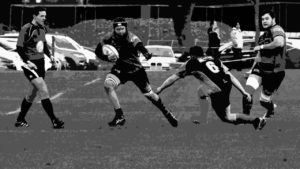It doesn’t matter how thoroughly you warm up, or how physically prepared you are for the demands of rugby and rugby training, sometimes it’s just your turn to get injured. Of course, we hope any injuries you suffer are infrequent, minor, and that you recover quickly!
In many cases, injured players are told they need to rest, but ruggers are notoriously committed to their sport, and are often too stubborn and competitive to heed this advice. Also, as rugby is such a tough game, if you took time off every time you were injured, you’d probably only play a couple of matches per season!
Because we know that many of you will train through and around injuries, we have collated some useful workout modifications that will allow you to maintain fitness and strength despite being hurt.
This is not meant to replace the advice of your team doctor or any other medical professional; if they say you need to rest, you probably should. But, if you MUST train despite being injured, these strategies will allow you to exercise without making your existing problems worse.
1. Super slow
Super slow is a type of strength training that involves light to moderate weights, low reps, no momentum, and a slow, deliberate tempo. This combination provides your muscles with adequate stimulation to maintain strength and size, but without the usual joint, tendon, and muscle stress.
To use the super slow training method, select a weight that is around 30-50% of your normal training weight. Yes – it does need to be that light! Then do your reps, taking around six seconds to lift the weight and six seconds to lower it. There should be no pauses at the top or the bottom of each rep.
Because each rep takes longer, you won’t be able to do as many as normal, and 4-8 reps is a good target to aim for. This will still equate to a total time under tension of 48-96 seconds which is about right for hypertrophy.
Warning: Super slow could just as easily be called super-boring! If you love hoisting heavy weights, this method will be a mental and physical shock. However, it does make strength training less mechanically stressful, so it’s a valuable addition to your workout arsenal.
Check out this video to see some super slow in (non) action!
2. Resistance bands
When you lift weights, getting the weight moving requires momentum. Going from a dead stop to moving is called overcoming the moment of inertia, and is arguably the most stressful part of any exercise.
However, when you use resistance bands, there is no moment of inertia to overcome, and the resistance increases gradually as you stretch the band. This means less stress at the start of each rep, but plenty of muscle tension at the end.
You can use bands exclusively, or combine them with free-weight exercises. This latter option is probably best for ruggers, as it allows you to stick with your usual training routine. Just reduce the weights, add some bands, and enjoy a productive but less injurious workout.
See how to use resistance bands for the barbell deadlift here:
3. Blood flow restriction training
Blood flow restriction (BFR) training, also known as occlusion training, is a bodybuilding method that comes from the world of medicine. It provides an effective way to build or maintain muscle size and strength with very light weights – as little as 20-40% of your 1RM – which minimizes joint stress.
With BFR training, you wrap a wide stretchy band around your target limb to limit blood flow into and out of that muscle. You then do your reps as normal. The reduction in blood flow means that, despite using light weights, lactic acid builds up rapidly, and that increases both testosterone and human growth hormone production. You’ll also get a wicked pump, bro! Without removing the bands, and after a short rest of 30-60 seconds, do another set or two.
BFR training works best for the legs and arms. The band should be tied off at the top of your thigh or the top of your arm, and should be tight enough to partially reduce blood flow but not stop it altogether – around six/seven out of ten on a notional tightness score.
For more on BFR training, check out this video:
4. Isometrics
If you have a joint injury, the usual prescription of light weights and higher-than-normal reps could make matters worse, especially if the injury is the result of wear and tear. Isometrics is a form of exercise that produces a lot of muscle tension, but no actual joint movement.
With isometrics, you push or pull against an immovable object. This creates lot of muscle tension which will build or preserve strength despite not moving. No movement means less joint stress.
It’s important to note that the strength you develop with isometrics is joint angle-specific. In other words, if you do an isometric squat with your knees bent to 90 degrees, you’ll only develop strength at +/- 15 degrees above and below that angle. This is easily remedied by doing several holds in different positions.
Many people turn isometrics into a test of mental and physical endurance by holding for a long time e.g. planks and wall squats. This will NOT do much for your strength or muscle size. Instead, concentrate on generating maximal force for 10-20 seconds, leaving the three-minute wall squats and planks to the Zumba crowd.
You can use isometrics with almost any exercise you can think off. Here as a demonstration of isometric barbell squats:
5. Movement modifications
In many instances, injuries can be made worse by specific movements. For example, your shoulders might hurt when you bench press, your elbows might hurt when you do barbell curls, or your knees might hurt when you do deep squats.
In a lot of cases, the solution is easy – just modify your chosen exercise so it doesn’t hurt.
This may mean swapping from barbells to dumbbells, or from free weights to cables, changing your grip width, or altering your foot position. Experiment to see if movement modifications reduce your level of pain.
6. Train the non-injured limb only
If you have an injured limb that precludes any exercise at all, you may be able to maintain at least some strength by intensely working the non-injured limb. This is called cross education or cross transference.
If you have a single limb injury, look for ways to exercise your non-injured limb e.g. single arm bench presses, shoulder presses, and pulldowns, and single leg squats and Romanian deadlifts. As an added bonus, single limb or unilateral exercises are also great for enhancing balance, coordination, and core strength. Read more about this phenomenon here.
7. Partial reps
In many instances, the start or midpoint of your rep is the part that hurts the most e.g. the bottom of the squat, the start of a deadlift, and the bottom of the bench press. This is because mechanically speaking you are in a disadvantageous position that can cause injuries or make existing injuries worse.
Partial reps allow you to focus on the less risky outer range of motion, which means you should be able to maintain strength despite being injured. Good partial rep options include:
- Squat to pins (half or even quarter-depth squats)
- Bench press to pins
- Deadlift from blocks
- Rack deadlifts
- Overhead press to pins
Wherever possible, do partial reps to a specific stopping point e.g. the pins on a squat rack, or lifting blocks, to ensure each rep is the same.
Check out this video to see how to do rack deadlifts and deadlifts from blocks:
8. Hit the pool
Lower limb injuries can make cardio very difficult. Knee, ankle, foot, or hip problems do not cope well with impact, and even rowing or cycling, which are non-impact, may also prove painful. If you have a lower limb injury that stops you from doing traditional cardio, hit the pool and do some deep water running instead.
Of course, you could swim for fitness, but to get a good training effect from swimming, you need to be a proficient swimmer, otherwise poor technique could undermine your workout. Deep water running is simple, and even if you aren’t a great swimmer, it’ll still work for you.
Deep water running is a non-injurious alternative to pounding the pavement, and will allow you to maintain or even improve your cardiovascular fitness. You can even do sprints too. To maintain a good running/sprinting position, use a buoyancy vest or aqua jogging belt to keep you upright and afloat.
Check out this video for more on deep water running:
Being injured does not have to mean time off from training. With some simple exercise modifications, combined with a diet high in muscle-repairing protein, you should be able to train around and through many of your aches and pains, maintaining or even improving your fitness and strength. It’s important that you listen to your body, but that doesn’t mean you have to coddle it; you are a rugger after all!


